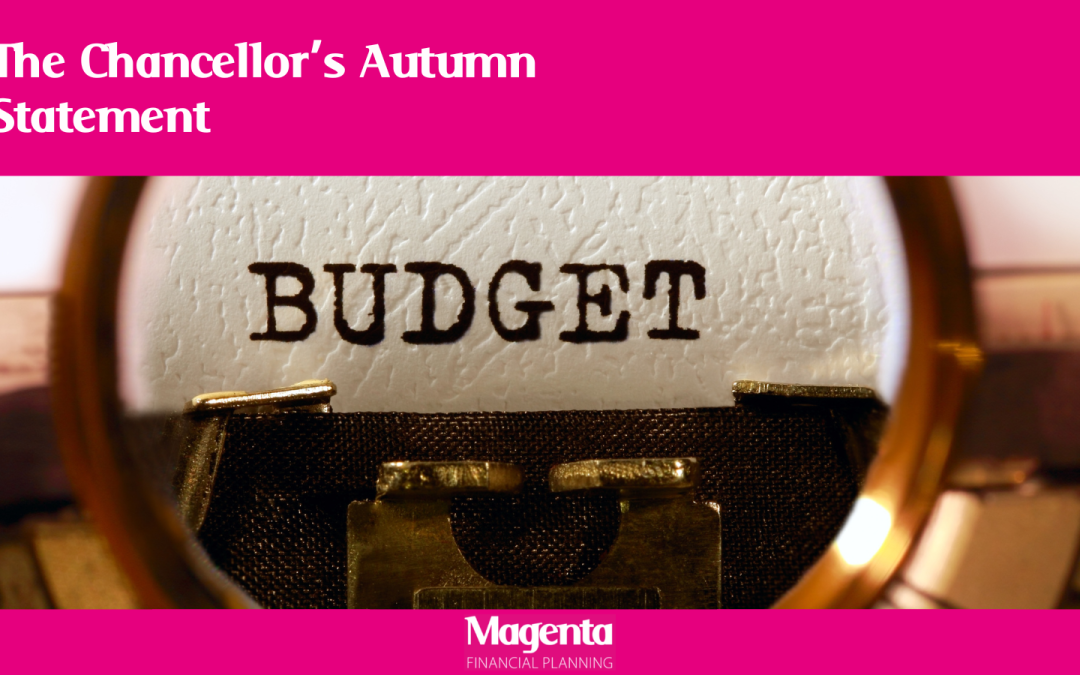Like us, you’re probably struggling to keep up with the current pace of changes the current government have made in the last 9 months, but yet again, last week we saw the new Chancellor, Jeremy Hunt, deliver the Autumn Statement and it included a number of tax measures aimed at improving the government’s finances.
Whilst there were no increases to the main rates of tax, reductions to various tax bands and allowances were announced and an extension to the period for which many allowances and bands have been frozen.
The Autumn Statement set out further steps on taxation and spending, with the intention that each contributes in a broadly balanced way to repairing the public finances, while protecting the most vulnerable.
In this blog, we have summarised the main elements of the Autumn Statement that are relevant to the majority of our clients.
We’ve added in italics some information where we think this will need to be considered further in financial planning meetings.
If you have any questions about how this will impact your personal circumstances, just get in touch.
Taxation
Additional rate tax threshold
From 6 April 2023, additional rate tax will apply to income above £125,140 rather than the current £150,000. The new threshold of £125,140 ties in with the income figure at which the personal allowance is completely lost.
For those earning higher than this new allowance, careful income tax planning, using tax efficient investments, such as pensions and where suitable, VCTs or EIS may be suitable.
Tax and national insurance thresholds
Apart from the additional rate threshold change outlined above, all other income tax, inheritance tax and national insurance thresholds and allowances will be frozen until April 2028 (they had already been frozen to April 2026 so this measure extends this by another 2 years).
Known as a ‘stealth tax’ these freezes will impact us all. We known many clients will be most impacted by income tax and inheritance tax threshold freezes. IHT threshold was frozen to 2026 and now this will be 2028. The Nil Rate Band threshold hasn’t increased since 2009, albeit for some people, the introduction of the Residence Nil Rate band has helped. Magenta will be running a webinar about Inheritance Tax in early 2023.
Dividend allowance
Currently set at £2,000 pa this will reduce as shown below:
- To £1,000 from April 2023
- To £500 from April 2024
For those who hold taxable investments (typically those outside an ISA or Pension wrapper) the dividend allowance reduction could impact the tax payable on your investments. Ensuring ISA and Pension allowances are utilised every year can minimise the taxable portfolio.
Capital gains tax annual exempt amount
Currently set at £12,300 pa this will reduce as shown below:
- To £6,000 from April 2023
- To £3,000 from April 2024
For those who hold taxable investments (typically those outside an ISA or Pension wrapper, and / or in property) the reduction in the Capital Gains exemption is quite significant, where gains are made in the tax year. Careful planning around disposals will become more important each tax year. Disposing of significant gains in this tax year, before the change in April 2023, may be something you wish to discuss and consider.
Stamp duty land tax (SDLT)
The cuts to SDLT that took effect from 23 September this year (shown below) will end on 31 March 2025. The level at which people begin paying Stamp Duty Land Tax (SDLT) was increased on 23 September from £125,000 to £250,000.
For first-time buyers the level at which they begin paying stamp duty has been increased from £300,000 to £425,000. In addition, the government is allowing first-time buyers to access the relief when they buy a property costing less than £625,000 rather than the current £500,000.
Pensions
Pension triple lock will apply in April 2023
Meaning that the state pension will increase by inflation of 10.1% in April. A full weekly basic State Pension will increase from £141.85 to £156.20, and the new weekly State Pension will increase from £185.15 to £203.85.
State benefits and support
Energy Price Guarantee
This currently fixes the cost of energy so that a ‘typical’ household pays the equivalent of £2,500 on their energy bills a year. From April 2023, this will change so that the typical household will then pay on average £3,000 a year.
Pension Credit
Will increase by 10.1% in April (i.e. the September 2022 annual CPI rate).
Cost of living payments
Will continue in 2023 at the rates below:
- £900 for those on means-tested benefits (paid in instalments)
- £300 for pensioners
- £150 for those on disability benefits
National Living Wage
From 1 April 2023, the National Living Wage (NLW) will increase by 9.7% to £10.42 an hour for workers aged 23 and over. Young people and apprentices on the National Minimum Wage (NMW) rates will also see a boost to their wages. Rates will be increased for people aged 21-22 by 10.9% to £10.18 an hour, for those aged 18-20 by 9.7% to £7.49 an hour, for 16-17 year olds by 9.7% to £5.28 an hour, and for Apprentices by 9.7% to £5.28 an hour.
Social care
The Dilnot reforms, including the introduction of the £86,000 cap on care fees, which were due to be introduced in October 2023, have been postponed for two years.
As always, if you want to have a chat about how any of this may impact you, please get in touch on 01656 760670.
Please feel free to share this content if you think this could be of interest to someone you know, or your social network, via the buttons below.

